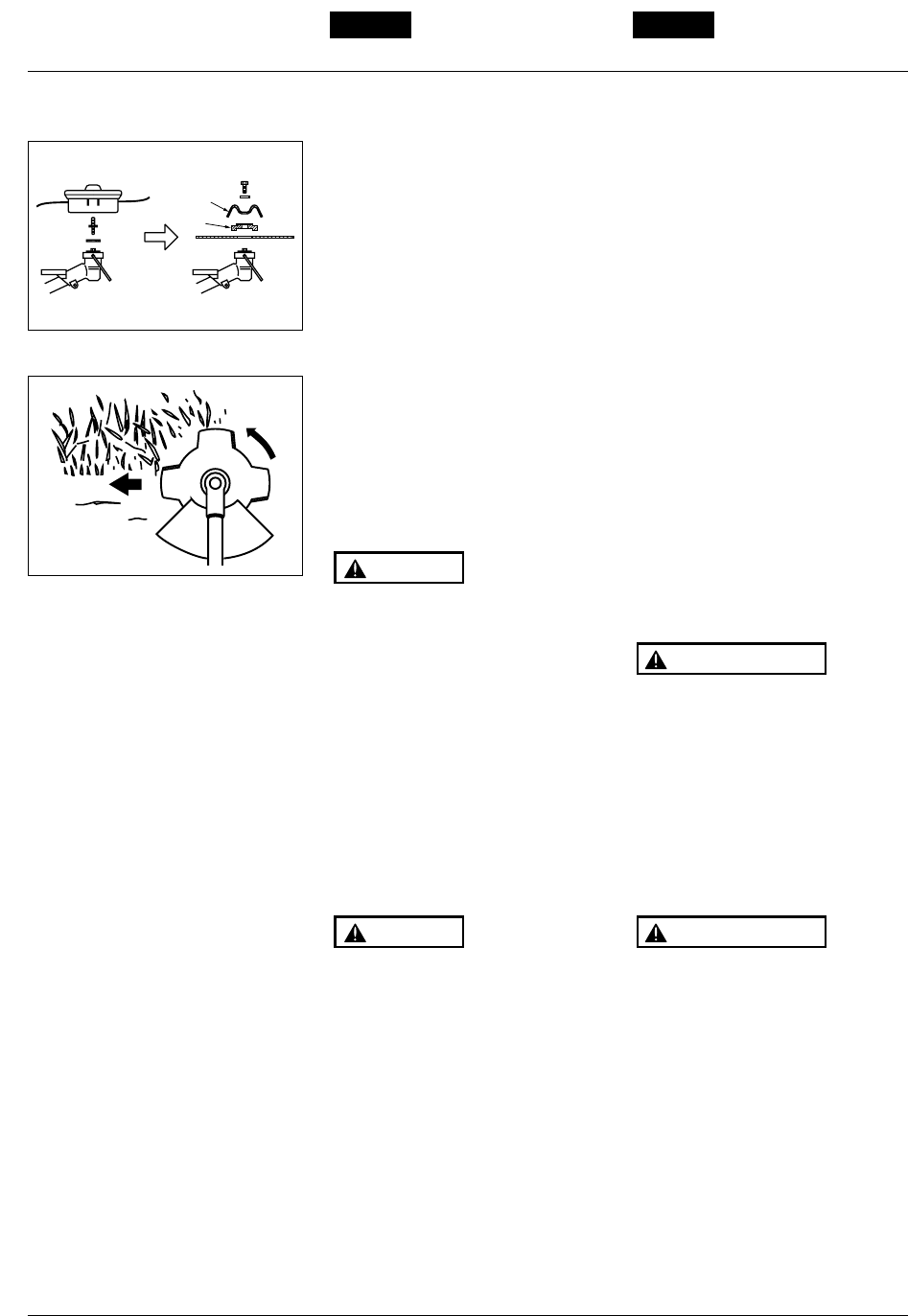
English Français
8. Operation 8. Fonctionnement
40
■ SET UP
1. Detach the line head assembly
completely. (OP9)
2. Put the blade making the marked side
face the holder, put the outer holders,
and fasten the blade by the washer and
the blade bolt. (OP9)
(1)Cover 6420-13280
(2)Holder 6019-13250
■ CUTTING METHOD
(a)Use the front left side cutting.
(b)Guide the blade from your right to left
with it tilted slightly to your left. (OP10)
(c) When mowing a wide area, start
working from your left end to avoid
interference of cut grass.
(d)The blade may be seized by weeds if
the engine speed is too low, or the
blade cuts too deep into weeds. Adjust
the engine speed and cutting depth
according to the condition of object.
• If the grass or other object gets
caught in the blade, or if the unit
starts to shake or vibrate, turn off the
engine and check the whole unit.
Change the blade if it has been
damaged.
• Turn off the engine and make sure
the blade has completely stop before
checking the blade, and removing
any object got caught in.
■ CONTROLLING BLADE BOUNCE
• Kick out can cause serious personal
injury. Carefully study this section. It
is important that you understand what
causes kick out, how you can reduce
the chance of kick out and how you can
remain in control of the unit if kick out
does occur.
1. What causes kick out:
• Kick out can occur when the moving
blade contacts an object that it cannot
cut. This contact causes the blade to
stop for an instant and then suddenly
move or ”bounce” away from the object
that was hit. The operator can lose
control of the unit and the blade can
cause serious personal injury to the
operator or any person nearby if the
WARNING
WARNING
■ INSTALLATION
1. Détacher complètement l'assemblage
de la tête de ligne(OP9).
2. Mettre la lame de façon à ce que son
côté marqué soit en face du support,
mettre les supports extérieurs et fixer la
lame entre la rondelle et le verrou
(OP9).
(1)gaine 6420-13280
(2)Support 6019-13250
■ METHODE DE COUPE
(a)Couper avec le côté gauche et avant
de la lame.
(b)Guider la lame de droite à gauche en
l’inclinant légèrement sur la gauche
(OP10).
(c) Lors de la coupe d’une zone de grande
largeur, commencer le travail par la
gauche pour ne pas être gêné par
l’herbe déjà coupée.
(d)La lame peut être bloquée par l’herbe
si la vitesse du moteur est trop lente ou
si elle est enfoncée trop profondément
et rapidement dans l’herbe. Régler la
vitesse du moteur et l’engagement de
la lame en fonction du travail à
effectuer.
• Si de l’herbe ou tout autre objet se
coince dans la lame ou si la machine
se met à vibrer, arrêter aussitôt le
moteur et vérifier la
débroussailleuse. Changer la lame si
elle est endommagée.
• Arrêter le moteur et attendre que la
lame soit complètement à l’arrêt
avant de la vérifier et d’enlever le
moindre objet coincé.
■ CONTROLE DES COUPS DE RECUL
• Les coups de recul peuvent causer de
sérieuses blessures. Etudier
attentivement cette section. Il est
important de comprendre la cause des
coups de recul, de savoir comment
réduire leur éventualité et de conserver
le contrôle de la machine dans ces
circonstances.
1. Cause des coups de recul :
• Les coups de recul se produisent
lorsque la lame rencontre un objet
qu’elle ne peut couper. Ce genre de
contact arrête la lame pendant un
instant puis rebondit soudainement en
se libérant de l’objet du contact.
L’opérateur peut perdre le contrôle de
AVERTISSEMENT
AVERTISSEMENT
OP10
(1)
(2)
OP9


















